Schipperke
Canis lupus
Schipperkes were used to hunt and kill rodents on Belgian ships.
Advertisement
Schipperke Facts
- Fun Fact
- Schipperkes were used to hunt and kill rodents on Belgian ships.
- Temperament
- Confident and lively
- Diet
- Omnivore
Schipperke as a Pet:
- General Health
- Energy Level
- Shedability
- Trainability
- Intelligence
- Tendency to Chew
- Size
- Family and kid friendliness
- Yappiness / Barking
- High
- Separation Anxiety
- Moderate
- Preferred Temperature
- Average climate
- Exercise Needs
- Moderate
- Friendly With Other Dogs
- Moderate
- Pure bred cost to own
- $700-$2000
- Dog group
- Non-sporting
- Male weight
- 13-16 lbs
- Female weight
- 12-15 lbs
This post may contain affiliate links to our partners like Chewy, Amazon, and others. Purchasing through these helps us further the A-Z Animals mission to educate about the world's species.
View all of the Schipperke images!
Schipperkes are sometimes called Belgium barge dogs because they hunted rodents on barges.
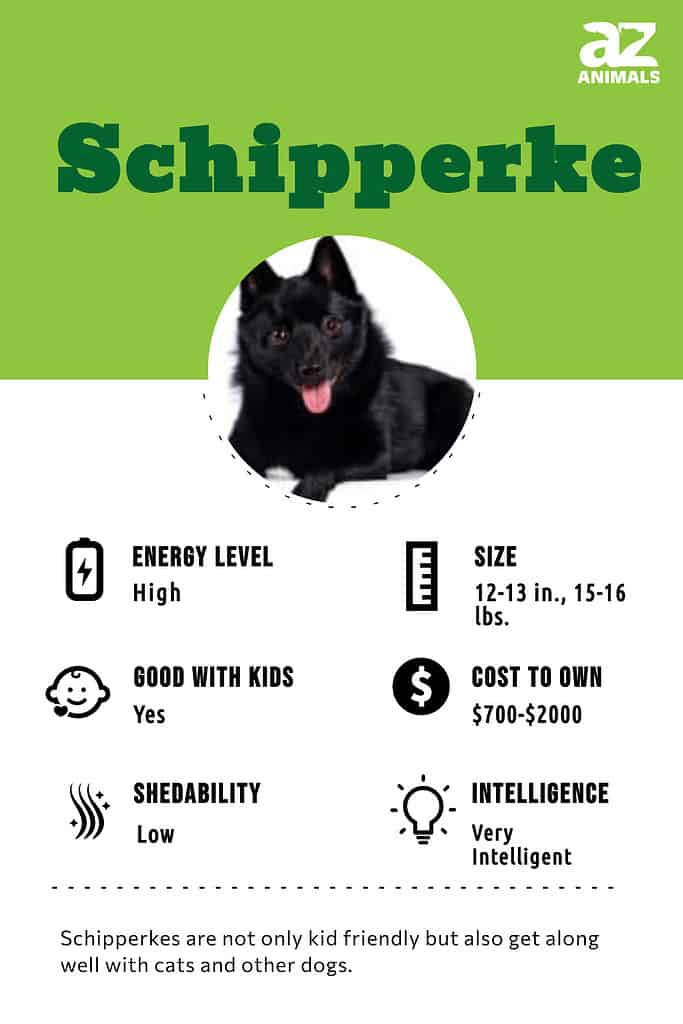
Schipperkes are sturdy, active dogs with a sense of mischief. With its pointed ears and curious eyes, this dog is always on alert. Its temperament is friendly and playful. Although it is best known for having a black coat, the breed has coats in other colors. This dog is a member of the non-sporting group.
See all of our expert product reviews.
The history of this dog starts in Belgium. They were used to hunt rats and other rodents hiding on ships and barges in Brussels. This hard work earned them the nickname, “little captain.” They are also known as mini-sheepdogs, Belgian barge dogs, and Schipps. Since a household may not need an expert rodent hunter, this affectionate dog makes a sweet companion for family members.
The 9 Different Types
There are 9 mixes of the Schipperke. The name of the mixed breed and that of the other parent breed are listed below:
- Schipese – Maltese
- Schip Coton – Coton de Tulear
- Schipper-Chi – Chihuahua
- Schipper-Pin – Miniature Pinscher
- Schip-A-Pom – Pomeranian
- Schipper-Poo – Poodle
- Skip-Shzu – Shih Tzu
- Corgi Schip – Welsh Corgi
- Westeke – West Highland White Terrier
3 Pros and Cons of Ownership
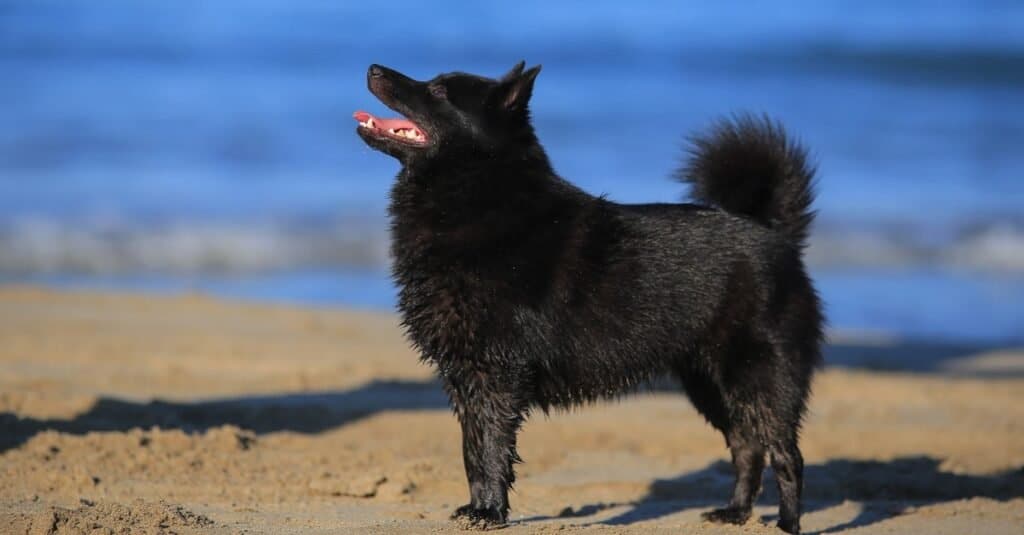
The Schipperke is a small dog that gets along well with children .
©Melounix/Shutterstock.com
| Pros | Cons |
|---|---|
| Small dogs These mini dogs are lightweight, making them easy to take on car rides and out for other fun activities. | Chewing activity This breed can chew and destroy items when it feels anxious or lonely. |
| A child-friendly pooch This pet gets along well with younger and older kids. | Barking can be an issue If this dog isn’t socialized, it will bark excessively. |
| Light shedding Although these canines shed a little more heavily two times per year, they’re generally known as light shedders. | It may not be cat-friendly When this dog is not socialized, it is likely to chase the family cat. |
Size and Weight
The Schipperkes are considered small dogs. A male adult Schipperke achieves a height of 13 inches at the shoulder and an adult female is 12 inches. Males can weigh 16 pounds as adult dogs while females weigh 15 pounds. A puppy that’s 7 weeks old weighs from 6 to 7 pounds. This breed is fully grown at 8 months.
Health and Entertainment for your Schipperke
See all of our expert product reviews.
| Height (Male) | 13 inches |
| Height (Female) | 12 inches |
| Weight (Male) | 16 lbs. |
| Weight (Female) | 15 lbs. |
Common Health Issues
Although it has a long lifespan, this dog has a few health challenges to consider. One is a luxating patella. Essentially, this is when the dog’s kneecap moves out of its proper place. Sometimes this is a mild condition, and the kneecap moves back into place on its own. In other situations, surgery is needed to move it back into alignment.
Tracheal collapse is a second health issue common to this breed. Tracheal collapse is when the cartilage surrounding the dog’s windpipe weakens causing breathing trouble. Medication can help with this issue and sometimes surgery is needed for more extreme cases.
Distichiasis is an eye condition common in these dogs. This condition involves extra eyelashes that grow inside a dog’s eyelid. Not surprisingly, this causes the dog pain and can harm the eye itself. Removing the hairs is one solution, though this has to be repeated every few weeks due to regrowth. Salve applied to the eyelid can help to soothe the condition but must be done every day. The most common health issues of this dog include:
- Luxating patella
- Tracheal collapse
- Distichiasis
Temperament and Behavior
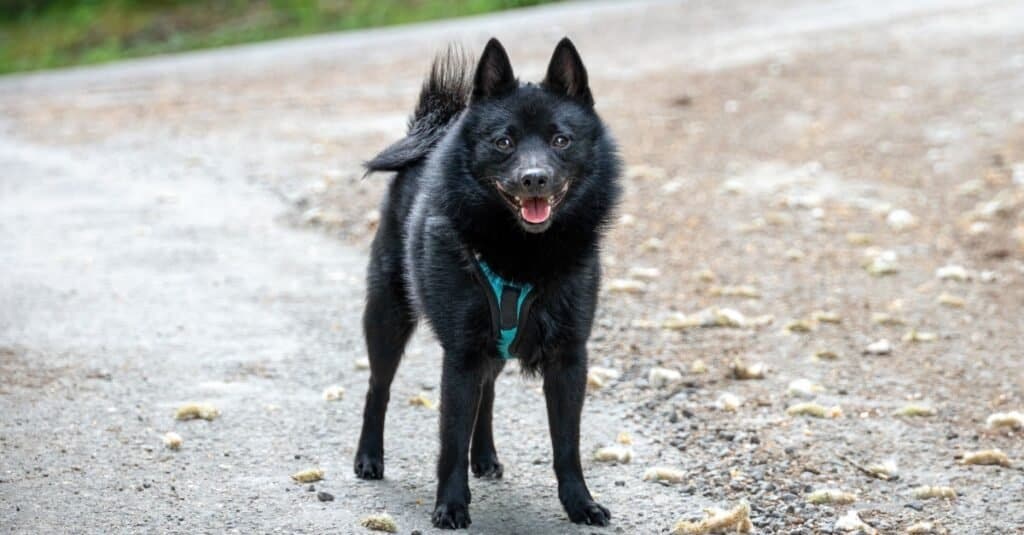
Schipperkes have a lively personality, energy, alertness, and confidence.
©Machacekcz/Shutterstock.com
The lively personality of this pooch is one of its most popular characteristics. These dogs are a mix of energy and confidence. Socialized Schipperkes have affectionate behavior towards kids and adults. They are a fun choice for a family dedicated to remaining active throughout the year.
Alertness is one of the traits that make this dog excellent at watching over a household. It is likely to bark at strangers on the property. A socialized Schipperke is adaptable and gets along with other pets in a household. Its size makes a Schipperke a good option for families who live in apartments.
Care
Bringing a puppy or adult canine home from a breeder or rescue organization means you are responsible for all of its care. Learning about its diet, exercise needs, training, and grooming routine contributes to the level of care you give this furry pet.
Best Dog Food
Feeding a Schipperke puppy the right type of diet can help it to maintain good health. The same goes for adult dogs. The following are some of the nutrients to include in the diet of this pet:
Schipperke puppy food: Turkey, chicken, and duck are all lean proteins that build up bones and support joint health. These puppies are especially energetic, so they need fat in their diet as well. Omega-6 and Omega-3 fatty acids are good for this breed’s hair and skin health. Vitamin A helps a puppy’s eye health. Vitamin B6 supports the proper function of this puppy’s nervous system. Don’t forget to include fiber in this puppy’s daily diet. Fiber contributes to its digestive health.
Schipperke adult dog food: Protein is important in an adult dog’s diet too. Chicken, fish, and lamb are all good sources of lean protein. As this breed grows, provide it with less fat than it received as a puppy. A smaller amount of fat still provides gives it enough energy to run around and play. Vitamin C is useful as an antioxidant to fight against free radicals. Calcium supports the bone health of a breed that can suffer from patellar luxation.
Calcium is also an important nutrient involved in proper cartilage formation which may help prevent Schipperkes from suffering from tracheal collapse.
So at A-Z Animals, we say that the best dog food for Schipperkes is NUTRO NATURAL CHOICE Natural Adult & Senior Dry Dog Food for Small & Toy Breeds.
Not only is this food formulated specifically for small breeds like the Schipperke, but since its nutrition is geared at both adult and senior dogs, it has adequate nutrition for the bones and joints. There’s an abundance of high-quality protein and calcium, plus copper for the connective tissues, all from wholesome and delicious non-GMO ingredients. In addition, there’s biotin for a shiny coat with plenty of antioxidants for a rock-solid immune system.
Read the ingredients and try out Nutro Natural Choice Adult and Senior Dog Food for Small and Toy Breeds on Chewy and Amazon.
- Chicken, lamb, and salmon recipe for toy dog breeds
- 15 superfoods to support heart and immune health, healthy coat and skin
- No corn, soy, wheat, artificial flavors, colors, or preservatives
Maintenance and Grooming
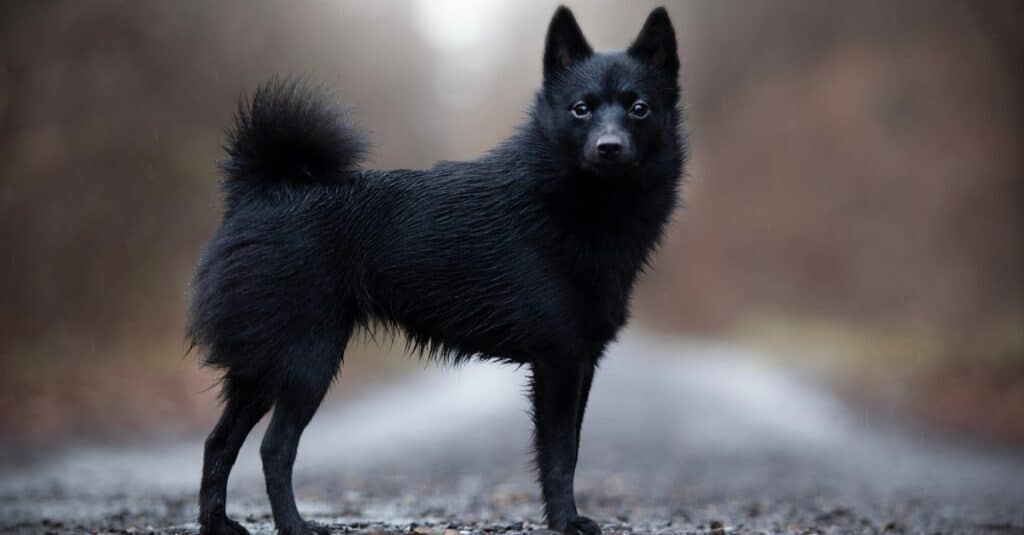
The small Belgian Schipperke dog is a light shedder except for seasonal changes in spring and autumn.
©nik174/Shutterstock.com
How much does a Schipperke shed? Generally speaking, these canines have light shedding activity. But, twice a year, their shedding increases as the seasons change in the spring and autumn.
The normal grooming regimen for this canine includes brushing its fluffy coat once per week. When there’s extra shedding in the spring and fall, brushing the dog two to three times per week can help to get rid of the additional loose hair.
A slicker brush is great for removing dead hair, dirt, and debris from this dog’s coat. It’s helpful if you take your pet outside to brush it, especially during those two periods of shedding. That way you can avoid sweeping up the hair and make the dog feel more comfortable during the process.
Training
These dogs are watchful and ready to learn, so they can be trained fairly easily. They like to wander and explore, so obedience training is essential for this breed to maintain its safety.
Exercise
Having this canine as a pet means you own an energetic canine! It needs up to 60 minutes of exercise each day. This routine could be broken into two sessions of 30 minutes each in the morning and evening. Taking this pet to a dog park to mix with other canines or to a secure area in a local park for a run are both ways to get your canine moving. Walking this breed of dog on a leash is a good idea until it is thoroughly trained to come when you call it. Of course, these pups get excited when playing ball, chase, frisbee, and other games with family members.
Puppies
These puppies are very fast and clever, and they love to check out everything in their surroundings. So, it’s critical to give a puppy a fenced-in place where it can look around without getting near a road or approaching another dangerous area.
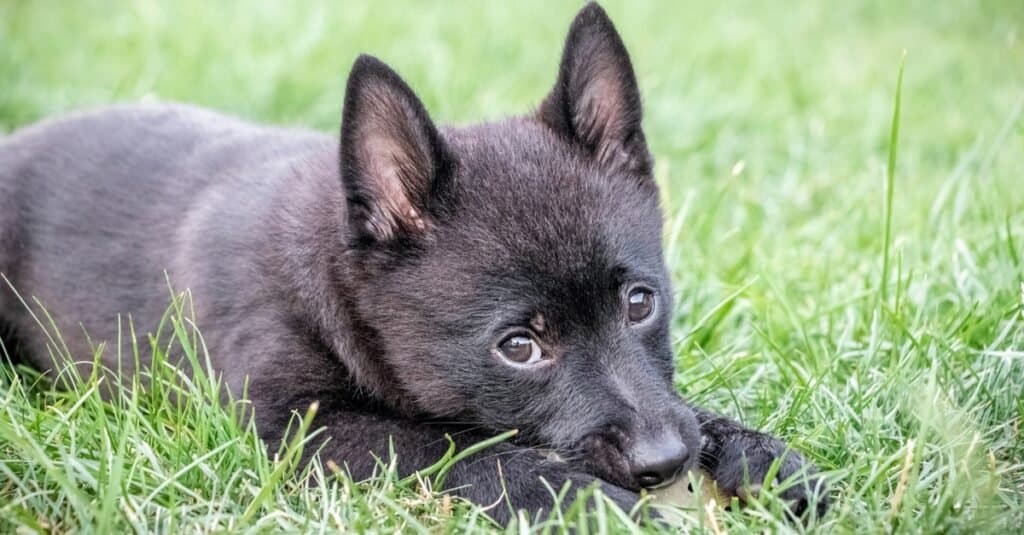
A Schipperke puppy will want to check out everything in its surroundings, so a fenced yard is best for safety.
©Jaroslav Machacek/Shutterstock.com
Children
Socializing a Schipperke puppy lets it know what type of behavior is acceptable. This includes how it should behave around children. Supervising the interactions between young children and this pet is important until a family knows the dog is fully socialized.
Similar Dogs
Three breeds that are similar to the Schipperke are the American Eskimo dog, Finnish spitz, and Keeshond:
- American Eskimo – Both dogs are social with a fun-loving temperament. In terms of size, American Eskimo dogs are larger than Schipperkes.
- Finnish Spitz – These dogs share a friendly, energetic nature. But, Schipperkes have a wider variety of coat colors.
- Keeshond – Both of these breeds make alert watchdogs. They are social with a thick, fluffy coat. Although they are about equal in height, Keeshonds are heavier.
Famous
Some famous individuals have owned this breed, which helped to boost its popularity.
- Actress Lucille Ball owned several of these pups after seeing the breed at a dog show. She traveled with one particular favorite canine named Ginger.
- Actor Mark Ruffalo has a rescue Belgian barge dog he keeps as a pet.
Popular Names
Look at some popular names for this curious pooch:
- Zoe
- Little Boy
- Munchkin
- Sammy
- Penny
- Pepper
- Cody
- Peanut
- Mini Dog
- Dash
Schipperke FAQs (Frequently Asked Questions)
What is a Schipperke?
A Schipperke is a small dog that originated in Belgium. Their nickname is ‘little captain.’ These dogs were used to hunt rats, mice, and other small animals on barges and ships in Brussels. Though most of these dogs are black, this breed’s coat can be other colors such as fawn, blue, red, or chocolate. This breed is known for its smart, alert temperament, love of playful activity, and long lifespan.
How much does Schipperke cost to own?
Buy this puppy from a breeder and the price is around $700. Adopting from a rescue organization means you’ll pay a small fee for a puppy or adult dog that was rescued from an unhealthy living situation.
Taking this pet to the vet for checkups and vaccinations means an owner pays from $300 to $500 yearly for canine healthcare. The price of each service varies among veterinary offices.
Feeding this little dog adds up to a monthly cost of $50 to $60.
Is a Schipperke good with kids?
Socialized Schipperkes are good with kids. They can be affectionate and gentle when playing with the kids in a family.
How long does a Schipperke live?
A Schipperke’s lifespan is 12 to 14 years. But, with the proper diet and exercise, this pet can certainly live longer than its normal lifespan.
Is a Schipperke a good canine?
Yes. There are many families who love this active, sweet-natured dog.
Do Schipperke dogs bark a lot?
They are prone to barking a lot. As a small canine, barking is one of its main methods of getting attention or calling attention to something else. But a mix of socialization and obedience training can help to decrease the behavior.
How much is a Schipperke?
The price of a puppy from a breeder is around $700.
Is a Schipperke a Spitz?
No, this canine isn’t a Spitz. Instead, it is sometimes referred to as a mini sheepdog.
Are Schipperkes rare?
They are considered rare today, but they are an official member of the American Kennel Club.
How to pronounce Schipperke?
When you pronounce Schipperke it should sound like you are saying the words skipper key.
Thank you for reading! Have some feedback for us? Contact the AZ Animals editorial team.
Sources
- Rocadog, Available here: https://www.rocadog.com/dog-blog-articles/schipperke-top-10-interesting-facts
- Wikipedia, Available here: https://en.wikipedia.org/wiki/Schipperke
- Davies The Veterinary Specialist, Available here: https://vetspecialists.co.uk/fact-sheets-post/distichiasis-extra-eyelashes-fact-sheet/
- American Kennel Club, Available here: https://www.akc.org/dog-breeds/schipperke/
- National Pure Bred Dog Day, Available here: https://nationalpurebreddogday.com/schipperke-not-always-black/


















